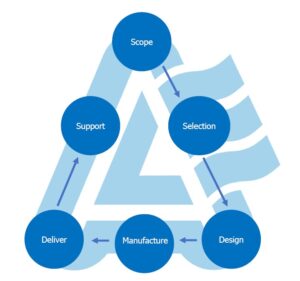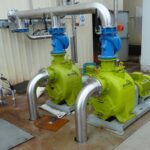Whether you operate an industrial pump or looking to purchase the right pump for your needs, the flow rate of the system is a crucial parameter. In this guide, we explain how to calculate the flow rate of your pump.
Why should I calculate the flow rate?
Flow rate is the amount of fluid that the pump can transport within a given time. Knowing the flow rate of your pump can help you achieve two key things:
- You can figure out if your system is working efficiently. If you know the expected flow rate and the current flow rate, then you can identify if your system is underperforming. This helps you make the right action to improve the pump’s performance.
- You can figure out the right setup needed to transport the liquid/fluid at the desired volume.
How to calculate the required flow rate before installation?
Before you approach pump manufacturers your purchase needs, having an idea of the desired flow rate will help you plan the system design perfectly. If you calculate the required flow rate wrong, then you would install an oversized/undersized pump, which is not a good investment in the long run. So, you need to have a clear idea of the desired flow rate before ordering the perfect solution for the job.
You need to calculate three factors before ordering the right pumps:
- The type of fluid you need to pump – is it viscous or clear? What’s the temperature of the pumped fluid? Etc.
- The distance the fluid has to travel
- The volume of fluid that needs to be transported in a specific time
All these three factors will vary based on your industrial needs. The volume of fluid that you want to transport determines the flow rate of the pump. The type of fluid and the distance transported both play a huge role in impacting the flow rate that you can achieve. Hence, all these three factors play a crucial role in determining the size and type of pump needed. We highly recommend that you contact a pump sizing expert to help you decide the correct equipment to buy. At Allflo, we offer free pump sizing guidance for all our clients, to help them find the best pumps for their requirements.
How to calculate the flow rate of an existing pump system?
Calculating the desired flow rate of your pump is quite easy. Let’s say, you want to transport 300 litres of a fluid every 30 minutes, then your pump system has to transport 300/30 = 10 litres per minute or 0.167 litres per second. This is the desired flow rate, which is usually calculated before the installation. Once you have installed the pump, you need to monitor the flow rate periodically to determine if your pump is performing efficiently. You can check the pump’s performance by monitoring several factors. Right now, we’ll just calculate the flow rate.
You can measure the flow rate of an operating pump using either one of the following two methods:
- Use a flow meter – A flow meter is a simple device that does exactly what it means – it measures the amount of fluid passing through the system. Attach the flow meter to the discharge outlet. The reading on the meter gives you the flow rate of the system.
- Calculate flow rate manually by collecting fluid – You can collect the fluid at the output of the pump system using a bucket or vat. Measure the collected fluid, the time taken to collect it, and reverse engineer to find the flow rate. The formula for calculating the flow rate:
Flow rate = Volume of Liquid Collected / Time Taken
If there is a significant difference between desired flow rate and the actual flow rate, you can then carry on an inspection of the pump system to determine what’s wrong. Or if it’s time for a pump replacement, then Allflo has an excellent range of industrial pumps for all needs. Get in touch with our team to find the right pump for your specific needs.


























































































